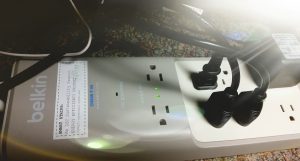This Week in LSC’s GreenCorps Office: Smart Strips Battle Phantom Loads
Another thoughtful post from our GreenCorps member, Chris…
Have you ever thought about how much time your computer and everything else at your office desk spends idle when you aren’t there? That thought is the starting point for one of the main projects of the GreenCorps service year. There is no way around it; your computer display(s) and all other electronics at your desk spend a lot of time sitting idle, and even though they’re not in use these appliances are all still drawing power from the outlet they are plugged into (it’s called phantom load, in case that shows up on an exam). “Phantom use” sounds diabolical…and it is. It accounts for more than 10 percent household energy use, $3 billion annually across the US! Find more information from takecontrolandsave.coop. It’s kind of like having leaking water facets in every room of your house.
Math-tastic
First off, some background on the amount of idle energy use of computers on campus and how we got to that number. We used the trusty kill-o-watt meters to measure a typical LSC employee workstation minus the laptop while one employee in our office was out for the week. This employee took her computer with her (as many employees do) so the energy used was only to power the docking station and monitors at her workstation. Using this week of data we came up with an approximation for the phantom energy use, that is to say the energy used when the equipment is still plugged in but not in use. We approximated that equipment is typically idle for 16 hours a day (24 hours minus the standard 8 hour workday). This means that during a standard 40 hour work week the equipment in your office sits idle for twice that time – 80 hours a week. Combined with the full weekend days of Saturday & Sunday this brings the grand total of idle time to 128 hours per week. The next part of the equation was take the amount of energy drawn over the course of the week in kilowatt hours and divide it by the number of hours it was plugged in. This gave us the energy use in kilowatt hours per hour and that number multiplied by 128 hours gave us the energy use for the idle equipment during a typical work week. The final step here is to take that calculation of energy and turn it into a dollar value. To do that we took the value for the workstations idle energy use and multiplied by an average of our electrical rate from MN Power for the 1st 6th months of 2017 which works out to .09 cents per kilowatt hour. We then multiplied by 4.3, the average number of weeks per month, to get a monthly rate and multiplied that number by 12 to get a yearly cost. After all of this math the grand total of the cost to power an idle workstation came to $2.26 per year without a computer in place, and $5.40 per year WITH a laptop left in place. This number doesn’t seem particularly high, but when multipled across all the employees on the LSC campus (let’s say approximately 450) this means LSC is spending $1,000 to $2,000 a year to power workstations that are not actively being used. This is a problem not only in the cost to operate them but also in the amount of greenhouse gas emissions generated to provide the energy. And this is just 1 example of phantom load on our campus.
What a Waste!
 Enter smart power strips as a solution. As you can guess from the name they are basically regular surge protectors with features to either automatically or manually stop the power draw from devices that are plugged into them. With approval from the Sustainability Council, we have purchased a handful of smart power strips to test (first with our Green Office Challenge participants). These strips, if purchased instead of regular surge protectors, will be especially useful where workstations are often idle. Our early trials are promising, showing almost ZERO phantom loss overnight. Stay tuned for more updates about the trial of these smart power strips and other phantom load analyses. If you would like a workstation energy assessment, let us know: sustainability@lsc.edu!
Enter smart power strips as a solution. As you can guess from the name they are basically regular surge protectors with features to either automatically or manually stop the power draw from devices that are plugged into them. With approval from the Sustainability Council, we have purchased a handful of smart power strips to test (first with our Green Office Challenge participants). These strips, if purchased instead of regular surge protectors, will be especially useful where workstations are often idle. Our early trials are promising, showing almost ZERO phantom loss overnight. Stay tuned for more updates about the trial of these smart power strips and other phantom load analyses. If you would like a workstation energy assessment, let us know: sustainability@lsc.edu!
Posted in: Good Stuff, GreenCorps
Leave a Comment (0) ↓